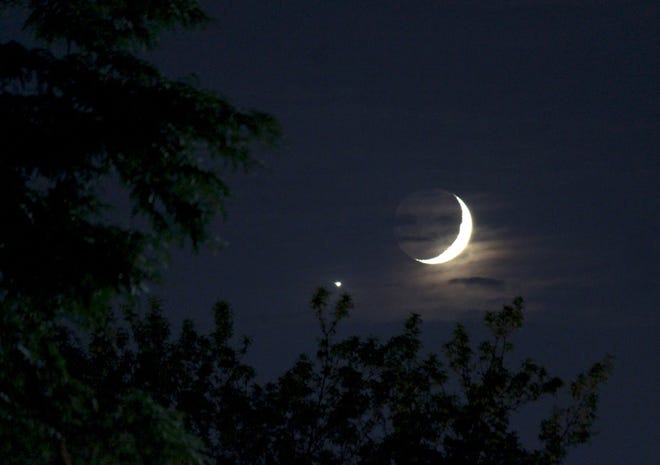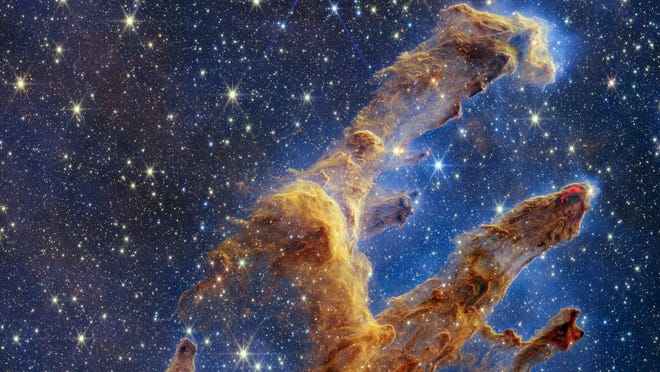- 2023 will bring rare stargazing opportunities – from a green comet to a partial solar eclipse with a “ring of fire.”
- Meteor showers and other celestial objects will also light up the night sky all year long.
- Here are the best stargazing events to see in 2023, most with the naked eye, and how to watch.
Meteor showers and other celestial objects will light up the night sky almost every month this year. Most are visible to the naked eye – without a telescope or binoculars – if you know the right times and places to view them.
Rare stargazing opportunities include a green comet and a partial solar eclipse with a “ring of fire” visible in parts of the southwestern United States.
Other treats include supermoons, great views of Earth’s sister planets and plenty of meteor showers.
What looks like meteors striking Earth’s atmosphere is usually the other way around. Most meteor showers happen when our planet passes through debris fields left by comets as it cruises on its annual journey around the sun. “Falling stars” or “fireballs” we see are bright hot air created as rocky bits burn up against our atmosphere, according to NASA. Most are tiny dust-size specs, and almost none make it to Earth’s surface.
Look up:A newly-discovered green comet is nearing Earth and it may be visible to the naked eye
NASA:A huge asteroid is going to fly by Earth. It’s one of the closest approaches ever.
Here is a list of what’s coming and where best to stargaze.
Where to watch
Night sky objects are best viewed away from towns or cities, where there’s minimal light. People in the country have an advantage, but there are places close to most towns you can go to find dark skies.
Good spots to watch include safe pull-offs along highways and back country roads, parks that allow visitors after dusk and vista points.
For advice on where to stargaze in your area, search for local astronomy clubs online and check NASA’s web page on how to find stargazing spots.
If you’re planning to view a meteor shower, keep in mind that although each radiates from a particular direction, meteors can hit the atmosphere anywhere; so look for them all over the night sky. The number of meteors visible per hour are based on darkest skies.
Meteor showers of 2023:A visual guide on where and when to view the year’s 11 sky shows
Here are best stargazing events to see in 2023, most with the naked eye, according to NASA, the Farmer’s Almanac, SeaSky.org and the American Meteor Society:
Rare green comet
January is your chance to view a once in a 50,000-year event: A green comet called C/2022 E3 (ZTF). First seen in March 2022, it may be visible to the naked eye, according to NASA, but comets are “tricky” to predict.
C/2022 E3 ZTF is closest to Earth on Feb. 2, but is most visible to the Northern Hemisphere in January. If you have a telescope or powerful binoculars, look for it in the north morning sky near Polaris/North Star, NASA said.
Graphics:A rare green comet is headed our way. Here’s how to see it without a telescope.
Best views of Mercury
On Jan. 30, the planet orbiting closest to the sun affords Earthlings a good opportunity to view it with the naked eye.
Look low in the southeast sky in the pre-sunrise hours. Other good dates to view Mercury are April 11, May 29, Aug. 10, Sept. 22 and Dec. 24.
Lyrids Meteor Shower
This small annual shower is best seen in the southern sky between midnight and dawn. It peaks from April 21 to 22.
Average meteors per hour: 10.
Eta Aquarids Meteor Shower
Peak viewing for this shower – caused by dust particles left by Halley’s Comet – is the morning of May 4 to 5. It rises/originates in the southeastern sky. Best times to watch are between midnight and dawn.
Average meteors per hour: 10.
Best view of Venus
The brightest, hottest planet in our solar system is most visible in the western sky on June 4. Best times to watch are the evening hours after sunset.
Almost as big as Earth, “Venus has a thick, toxic atmosphere filled with carbon dioxide and it’s perpetually shrouded in thick, yellowish clouds of sulfuric acid that trap heat, causing a runaway greenhouse effect,” according to NASA. Temperatures reach around 864 degrees Fahrenheit. The clouds that coat the planet reflect the sun’s light, making Venus the third brightest object seen from Earth after the sun and moon.

Delta Aquarids Meteor Shower
Best viewing for this shower is where it originates in the southern sky between midnight and dawn on July 29 to 30.
Average meteors per hour: 10.
What’s everyone talking about? Sign up for our trending newsletter to get the latest news of the day.
Perseids Meteor Shower
The Perseids is the best overall annual meteor shower. While it originates from the northeast, it can usually be seen in every direction.
The shower peaks on Aug. 11 and 13. Best times to view are midnight to dawn, but fireballs should be visible in the evening, too. Most years, Lassen Volcanic National Park hosts its annual Dark Sky Festival in August to watch the Perseids, with astronomy lectures and telescope viewing opportunities.
Average meteors per hour: 50.

Best view of Saturn
The solar system’s second largest planet and the one with the brightest rings is most visible on Aug. 27.
Saturn is visible to the naked eye, but its rings and a few of its 83 moons are visible with a basic telescope or powerful astro-binoculars.
Biggest supermoon, blue moon
The biggest full moon in 2023 happens on Aug. 31. It’s the closest point to Earth any full moon will come in 2023. It will also be a blue moon, the second full moon in August.
Other supermoons appearing almost as large shine July 3, Aug. 1 and Sept. 29.
Solar eclipse with ‘ring of fire’
For the price of a safe pair of eclipse glasses, North Americans can watch a partial solar eclipse on Oct. 14.
This is a special show for Californians, Nevadans, Texans and southern Oregonians who will be treated to a “ring of fire” as the moon passes over the center of the sun. For information on watching safely, go to NASA’s solar eclipse safety page.
Draconids Meteor Shower
This show peaks on Oct. 8 to 10 in the northwest sky. Best times to watch are evening hours before midnight.
Average meteors per hour: Six, but sometimes hundreds for brief periods.
Orionids Meteor Shower
Halley’s comet created this dust shower, which peaks from Oct. 20 to 21. It originates in the southern sky.
Average meteors per hour: 15.
Jupiter shines bright after Halloween
On Nov. 3, the solar system’s biggest planet will appear at its brightest this year. Jupiter is easily seen with the naked eye, but grab a pair of good binoculars or a telescope for a look at the largest of its 80 moons.
The gas giant orbits an average of 400 million miles from Earth, but scientists theorize it once spiraled as close as Mars in what is known as the Grant Tack.

Taurids meteor showers
These long, sparse showers are created when the Earth passes through two debris fields: One left by an asteroid, the other by a comet.
The South Taurids originate in the southern sky, and peak from Nov. 4 to 5. The North Taurids – which also originate in the southern sky – peak from Nov. 11 to 12. Best times to watch are 10 p.m. to midnight.
Average meteors per hour: Three to five.
Leonids Meteor Shower
Look to the southern sky to see the Leonids, peaking from Nov. 16 to 18. Best times to watch are between midnight and dawn.
This meteor shower varies, with a few fizzling fireballs per hour some years, then pounding the atmosphere with hundreds other years. This year will likely be a lighter shower.
Average meteors per hour: 10.
Andromedid Meteor Shower
This little shower peaks in the late evening on Nov. 25 to 27. It’s point of origin is the southern sky.
Average meteors per hour: Five.
Geminids Meteor Shower
Watch at any time of night to see this groovy shower, peaking on Dec. 13 and 14. It originates from the northeastern sky.
Average meteors per hour: 75.
Ursids Meteor Shower
This brief little shower – originating from the northern sky – is from debris left by comet 108P/Tuttle. It peaks on Dec. 21 and 22. Best times to watch are from midnight to dawn.
Average meteors per hour: Five.
Follow reporter Jessica Skropanic on Twitter @RS_JSkropanic.


